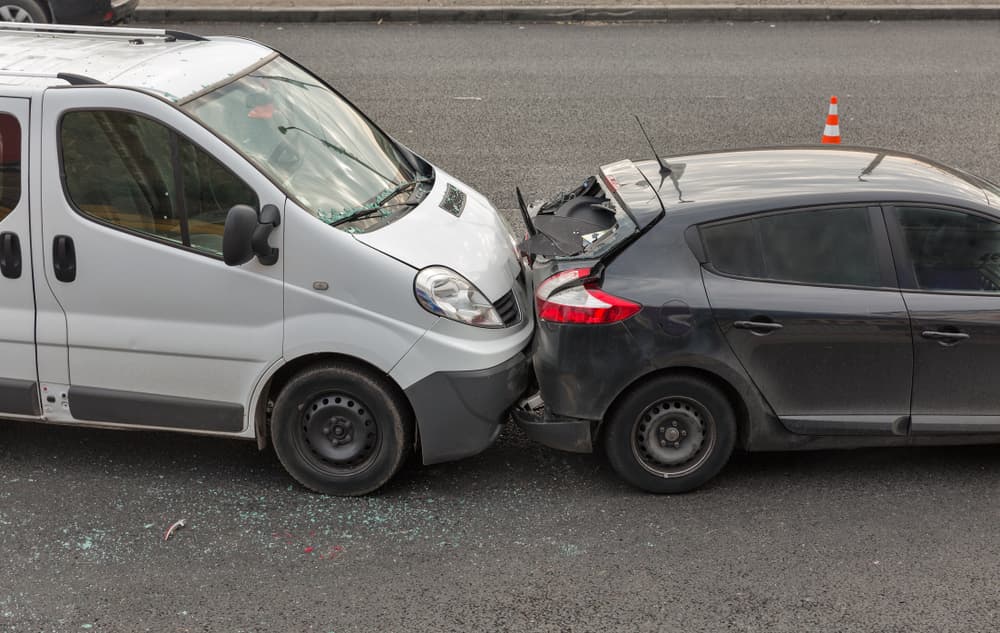Steven A. Bagen | July 1, 2024 | Car Accidents

Rear-end collisions are one of the most common types of car accidents. These incidents often result in significant property damage, medical bills, and lost wages. Understanding who is liable and how payment is determined is crucial for anyone involved in a rear-end collision.
After a rear-end collision, contact Bagen Law Accident Injury Lawyers, P.A.., at (800) 800-2575 for a free consultation. Our experienced team of car accident lawyers will navigate your case and secure the compensation you deserve, with no fee unless we win.
Determining Fault in Rear-End Collisions

Fault in rear-end collisions is usually straightforward but can involve nuances.
Common Causes of Rear-End Collisions
Rear-end collisions often occur due to:
- Distracted driving: Drivers fail to notice the vehicle in front has slowed or stopped.
- Speeding: Reduced reaction time makes stopping difficult.
- Tailgating: Following too closely leaves insufficient space to react.
- Weather conditions: Rain, snow, or ice increase stopping distances.
- Sudden stops: Unexpected stops by the lead vehicle can catch the trailing driver off guard.
Legal Principles of Fault
Typically, the trailing driver is presumed at fault, based on maintaining a safe following distance and being prepared for sudden stops.
Specific Exceptions to the General Rule
Exceptions to this rule include:
- Sudden stops: If the lead vehicle makes an abrupt stop without functioning brake lights, the trailing driver may not be fully at fault.
- Multi-car pile-ups: In chain-reaction crashes, multiple drivers may share responsibility, determined by the sequence of impacts.
- Mechanical failure: You can hold the driver liable if they neglect vehicle maintenance. But in cases of sudden mechanical failure, neither driver may bear fault. Potential issues include:
- Defective brakes: Failure to stop due to brake issues.
- Faulty taillights: Lack of visual signals leading to collisions.
- Manufacturer liability: Claims may be filed against the vehicle manufacturer.
Insurance Coverage for Rear-End Collisions
Understanding insurance coverage after a rear-end collision can be complex. Knowing how fault is determined and the types of coverage available is crucial.
Role of Liability Insurance
Liability insurance covers damages you cause to others. In a rear-end collision, the at-fault driver’s liability insurance typically covers:
- Property damage: Repairs or replacement of the damaged vehicle.
- Medical expenses: Costs of medical treatment for injuries.
- Lost wages: Compensation for time off work due to injuries.
How Insurance Companies Determine Fault and Coverage
Insurance companies investigate to determine fault, which can include:
- Reviewing police reports: Provide an official account of the accident.
- Examining vehicle damage: Indicates how the collision occurred.
- Interviewing witnesses: Provides additional perspectives.
- Analyzing traffic laws: Considers if any laws were violated.
Based on these factors, insurers assign fault and determine coverage.
Uninsured and Underinsured Motorists
If the at-fault driver lacks sufficient insurance, you might rely on your policy’s uninsured or underinsured motorist coverage. This can cover:
- Medical expenses
- Property damage
- Lost wages
Dealing with Insurance Companies and Denied Claims
Insurance companies always try to minimize their payout. If your claim is denied or underpaid, seek legal advice. A personal injury lawyer can negotiate with the insurance company or file a lawsuit if necessary.
Compensation for Damages
After a rear-end collision, you want a lawyer who understands the types of damages you can claim and how to calculate them so that you can maximize your compensation.
Types of Damages
- Property Damage
- Vehicle repairs: Costs to repair your vehicle.
- Vehicle replacement: If your vehicle is totaled, you may receive the market value of your car.
- Personal property: Compensation for any personal items damaged in the collision.
- Medical Expenses
- Emergency care: Costs for ambulance rides and emergency room visits.
- Ongoing treatment: Expenses for follow-up visits, physical therapy, and medications.
- Specialized care: Costs for surgeries or long-term care.
- Lost Wages
- Current wages: Compensation for time off work due to injuries.
- Future earnings: If injuries impact your ability to work long-term, you can claim lost earning potential.
- Non-Economic Damages
- Pain and suffering: Compensation for physical pain and emotional distress.
- Loss of enjoyment: If your injuries prevent you from enjoying hobbies or activities.
- Loss of consortium: Compensation for the impact on your relationship with your spouse.
How to Calculate Compensation
Compensation amounts are calculated based on various factors, including:
- Severity of injuries: More severe injuries typically result in higher compensation.
- Impact on daily life: How the injuries affect your ability to perform daily activities.
- Medical expenses: The total cost of medical care required.
- Duration of recovery: Longer recovery times can increase compensation amounts.
- Fault determination: If you are partially at fault, your compensation may be reduced.
Factors Influencing the Settlement Amount
Several factors can influence the final settlement amount, such as:
- Insurance policy limits: The maximum amount an insurance company will pay.
- Evidence strength: Strong evidence can support higher compensation claims.
- Legal representation: An experienced lawyer can negotiate a better settlement.
- Negotiation skills: Effective negotiation can significantly affect the settlement.
Working With a Personal Injury Lawyer
A personal injury lawyer can:
- Evaluate your case: Determine the strength of your claim and potential compensation.
- Negotiate with insurers: Handle communications and negotiations with insurance companies.
- Gather evidence: Collect and organize evidence to build a strong case.
- Represent you in court: If necessary, take your case to trial to fight for fair compensation.
Filing a Lawsuit if Necessary
If negotiations with the insurance company fail, you may need to file a lawsuit. The steps include:
- Filing the complaint: Your lawyer will draft and file a legal complaint against the at-fault party.
- Discovery process: Both parties exchange evidence and information related to the case.
- Settlement negotiations: Often, cases settle before going to trial through further negotiations.
- Trial: If a settlement is not reached, the case goes to trial where a judge or jury decides the outcome.
Special Considerations in Florida
Florida has unique insurance laws that can impact how rear-end collision claims are handled. Understanding these laws is essential for anyone involved in a rear-end collision in the state.
No-Fault Insurance Laws in Florida
Florida operates under a no-fault insurance system. This means that regardless of who is at fault for the accident, each driver’s own insurance covers their initial medical expenses and lost wages. Key aspects include:
- Personal Injury Protection (PIP): Florida drivers must carry PIP coverage, which pays up to $10,000 for medical expenses and lost wages.
- PIP Coverage: This coverage applies to the driver, passengers, and pedestrians injured in an accident, regardless of fault.
Impact on Rear-End Collision Claims
The no-fault system affects rear-end collision claims in several ways:
- Initial Medical Expenses: Your PIP coverage will cover your medical bills up to the policy limit.
- Threshold for Lawsuits: To file a lawsuit against the at-fault driver, your injuries must meet a certain severity threshold, such as permanent injury, significant scarring, or disfigurement.
- Economic Damages: If your damages exceed the limits of your PIP coverage, you may pursue compensation from the at-fault driver’s insurance for economic damages like medical bills and lost wages.
PIP Coverage and Its Limitations
While PIP coverage provides quick access to funds for immediate medical expenses, it has limitations:
- Coverage Limits: PIP only covers up to $10,000, which may not be sufficient for serious injuries.
- Non-Economic Damages: PIP does not cover non-economic damages such as pain and suffering.
- Out-of-Pocket Costs: If your medical bills exceed your PIP coverage, you may need to pay out of pocket until additional compensation is secured.
Comparison with States that Do Not Have No-Fault Laws
In states without no-fault laws, the at-fault driver’s insurance typically covers the medical expenses and damages. Key differences include:
- Fault-Based Claims: In non-no-fault states, the at-fault driver’s insurance covers damages, regardless of severity.
- Lawsuit Thresholds: There is no threshold for filing a lawsuit; you can sue for any injury-related expenses.
- Compensation Scope: Victims can claim both economic and non-economic damages without the limitations of PIP coverage.
Potential Injuries from Rear-End Collisions
Generally speaking, compensation increases the more numerous and severe your injuries are. Understanding the types of injuries commonly associated with these accidents helps your lawyer determine the maximum compensation you can receive.
Whiplash
Whiplash is the most common injury resulting from rear-end collisions. It occurs when the head and neck are suddenly jerked backward and then forward, similar to the motion of cracking a whip. Symptoms include:
- Neck pain and stiffness
- Headaches
- Shoulder and upper back pain
- Dizziness
- Numbness in the arms
Spinal Injuries
The spine is particularly vulnerable in rear-end collisions due to the force exerted on it.
Common spinal injuries include:
- Herniated discs: The impact can cause spinal discs to rupture or slip out of place, leading to pain and mobility issues.
- Facet joint injuries: Damage to the small joints between the vertebrae can cause chronic pain.
- Spinal cord injuries: Severe impacts can damage the spinal cord, potentially leading to paralysis.
Head and Face Injuries
Head and face injuries occur when the airbag fails to deploy or if the head hits the steering wheel, dashboard, or windows. Possible injuries include:
- Concussions and traumatic brain injuries (TBIs): These can result from the brain striking the inside of the skull.
- Facial fractures: The impact can break the nose, cheekbones, or jaw.
- Eye injuries: Trauma can cause damage to the eye or surrounding structures, leading to vision problems.
Arm and Hand Injuries
Drivers often brace themselves with their arms and hands during a collision, which can lead to:
- Fractures: The force of the impact can break bones in the arms, wrists, and hands.
- Dislocations: Joints may be forced out of place.
- Soft tissue injuries: Sprains, strains, and tendon damage are common.
Seatbelt Injuries
While seatbelts save lives, they can also cause injuries during a collision:
- Bruising and lacerations: The force of the seatbelt restraining your body can cause significant bruising or cuts.
- Rib fractures: The pressure from the seatbelt can break ribs, particularly in high-speed collisions.
- Internal injuries: The impact can cause damage to internal organs.
Steps to Take After a Rear-End Collision

Knowing what to do immediately after a rear-end collision can significantly affect the outcome of your insurance claim and potential lawsuit.
Important steps include:
- Seek Medical Attention: Always get a medical evaluation, even if you feel fine initially. If you do not seek medical attention but later want to file a claim, the insurance company can use this against you to argue that your damages aren’t serious.
- Report the Accident: Notify your insurance company promptly and provide accurate information. Failure to report it within a reasonable timespan can be used against you.
- Document Everything: Keep a record of all medical bills, repair estimates, correspondence with insurance companies, and any other expenses related to the accident. This documentation will be crucial in proving the extent of your damages and negotiating a fair settlement.
- Avoid Early Settlements: Insurance companies may offer a quick settlement that is often lower than what you might deserve. It’s best to wait until you fully understand the extent of your injuries and damages before accepting any offer.
- Avoid Posting on Social Media: Insurance companies may monitor your social media accounts to find posts or photos that could be used to dispute your claim. Even seemingly harmless posts could be taken out of context and used against you.
- Consult a Lawyer: Early legal advice can help navigate the claims process and avoid common pitfalls.
Why Bagen Law Accident Injury Lawyers, P.A..?
Choosing the right legal representation can make a significant difference in the outcome of your case. At Bagen Law Accident Injury Lawyers, P.A.., we bring over 100 years of combined experience and a proven track record of success to every client we represent.
Our dedicated team of personal injury attorneys understands the complexities of rear-end collision cases and works tirelessly to ensure you receive the compensation you deserve. With our no-fee guarantee, you can rest assured that you only pay if we win your case.
Contact Bagen Law Accident Injury Lawyers, P.A.., today at (800) 800-2575 for a free consultation.
